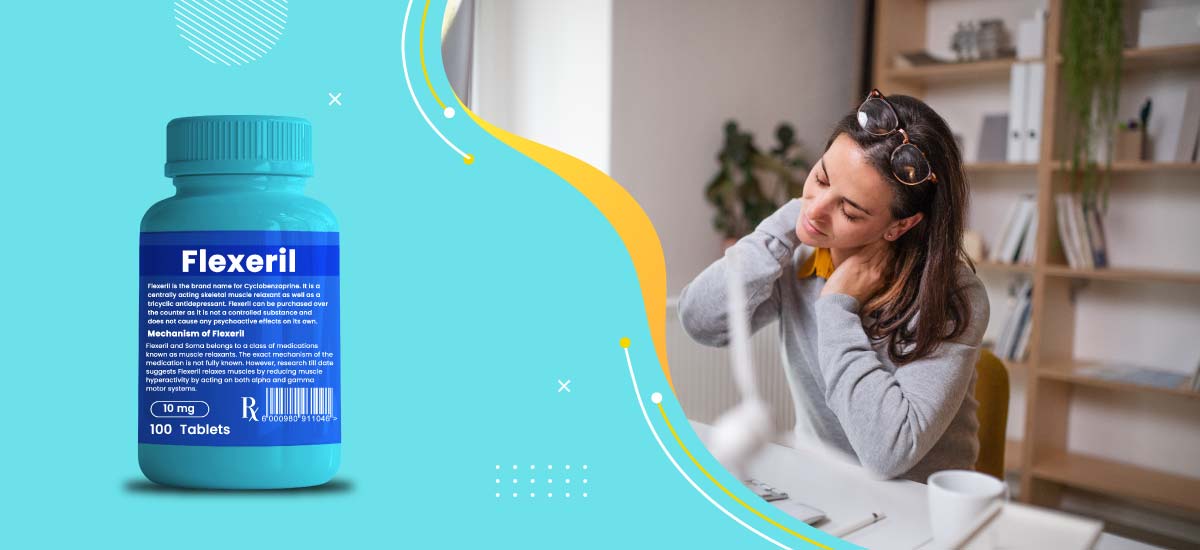The Best Fluffy Pancakes recipe you will fall in love with. Full of tips and tricks to help you make the best pancakes.

Cyclobenzaprine, also known by the brand name Flexeril, is a muscle relaxant medication used to treat muscle spasms and pain caused by musculoskeletal conditions such as strains, sprains, or injuries, even with its huge benefits cyclobenzaprine interactions with other drugs.
Flexeril® also known as “Cyclobenzaprine,” interacts with many medications and substances. These include medications that raise serotonin levels, like antidepressants. It can also interact with medications and substances that slow down brain activity. These include benzodiazepines, opioids, and alcohol.

Cyclobenzaprine interactions with other drugs
Like any medication, it can interact with other drugs, supplements, or foods, affecting its effectiveness and increasing the risk of side effects. Here are some common drug interactions of cyclobenzaprine:
📌 Antidepressants: Taking cyclobenzaprine with certain antidepressants, such as selective serotonin reuptake inhibitors (SSRIs) or monoamine oxidase inhibitors (MAOIs), may increase the risk of serotonin syndrome, a potentially life-threatening condition that causes symptoms such as high fever, agitation, confusion, muscle rigidity, and seizures.
📌 Opioids: Cyclobenzaprine should be used with caution when taken with opioids, as both drugs can cause sedation and respiratory depression. The risk of these side effects may be higher in elderly or debilitated patients.
📌 Sedatives: Taking cyclobenzaprine with other sedatives, such as benzodiazepines or barbiturates, may increase the risk of central nervous system depression and respiratory suppression.
📌 Alcohol: Drinking alcohol while taking cyclobenzaprine can increase the risk of drowsiness, dizziness, and impaired coordination.
📌 Grapefruit juice: Grapefruit juice can increase the blood levels of cyclobenzaprine, which can increase the risk of side effects. It is recommended to avoid grapefruit juice while taking this medication.
📌 Urinary acidifiers: Urinary acidifiers, such as ascorbic acid or ammonium chloride, can decrease the effectiveness of cyclobenzaprine by reducing its excretion from the body.
It is important to inform your healthcare provider about all the medications, supplements, and herbs you are taking before starting cyclobenzaprine. They can help monitor for potential possible drug interactions and adjust the dose or switch to a different medication if necessary.
Flexeril, also known by its generic name cyclobenzaprine, is a muscle relaxant medication usually prescribed to treat acute skeletal muscle spasms. While it has been shown to be effective at reducing pain and tension in the muscles, like any medication, there are potential side effects.
Common side effects of Flexeril include dizziness, dry mouth, fatigue, and drowsiness and dizziness. These symptoms usually diminish as the body adjusts to the medication. More severe, yet rare severe side effects can also occur, such as confusion, hallucinations, and seizures.
Because Flexeril can also interact with other medications, it is important for patients to notify their healthcare professionals of any other medications they are currently taking before beginning a prescription of Flexeril or when you are experiencing any flexeril side effects.
Patients who notice any unusual symptoms or who experience an allergic reaction while taking Flexeril should contact their doctor immediately.
What is cyclobenzaprine “Flexeril®”?
Cyclobenzaprine also known as Flexeril® is a muscle relaxant medication that is primarily used to treat skeletal muscle conditions, muscle stiffness such as spasms or pain caused by musculoskeletal injuries.
It works by acting on the central nervous system to reduce muscle contractions and spasms, thereby relieving muscle pain and improving mobility.
Flexeril® is typically taken orally in tablet form, and the dose and duration of treatment may vary depending on the severity of the condition being treated. Like all medications, cyclobenzaprine may cause side effects, such as drowsiness, dizziness, dry mouth, and fatigue.
It may also interact with other medications and should be used with caution in individuals with certain medical conditions or risk factors. Overall, cyclobenzaprine can be an effective treatment for muscle pain and discomfort when used appropriately under the direction of a healthcare provider.
What Other Drugs Will Interact With Cyclobenzaprine?
There are several drugs that may interact with Cyclobenzaprine, leading to potentially harmful effects. These include other muscle relaxants, antidepressants, anti-anxiety medications, sleeping pills, painkillers, and medications for high blood pressure or heart disease.
Combining Cyclobenzaprine with these drugs can increase the risk of drowsiness, dizziness, and difficulty breathing.
In some cases, it may also lead to more may report side effects serious side effects such as seizures, heart palpitations, and even coma. It is important to inform your doctor of all medications, supplements, and herbal remedies that you are taking before starting Cyclobenzaprine.
Your doctor may need to adjust the dose of your medication or prescribe an alternative drug to minimize the risk of interactions.
Also Read: “When your joints won’t let you lead a normal life, all you can do is hope for a miracle?” Try This…
What is the latest News About Cyclobenzaprine “Flexeril”?
The latest news about cyclobenzaprine is that Flexeril has been discontinued in the United States, and its use has decreased in recent years due to concerns about its potential side effects and the risk of abuse and dependence.
Read everything you may want to know about why was flexeril discontinued in the US., known by its brand name Flexeril, is that it is a commonly prescribed muscle relaxant. It works by blocking nerve impulses that are sent to the brain, which helps to relieve spasms, pain, and stiffness in muscles.
However, Flexeril is a controlled substance due to its potential for abuse and addiction. The drug is currently available in generic form, and its cost may vary depending on the type of insurance coverage that a patient has.
Patients are advised to use Flexeril only as directed by their doctors and keep it out of reach of children or anyone who might misuse it. Despite its risks, Flexeril continues to be a widely used medication for treating muscle spasms and pain.
What Is Flexeril® And What Does It Do?
Flexeril is a brand name for the generic drug cyclobenzaprine. It is a prescription medication used to treat muscle spasms and stiffness associated with musculoskeletal conditions such as strains, sprains, or injuries.
Flexeril works by relaxing the muscles, which can help reduce pain, improve mobility, and increase range of motion. It is thought to work by blocking nerve impulses that cause muscle contractions, allowing the muscles to relax and reducing the sensation of pain.
Flexeril is typically used as a short-term treatment for acute muscle pain and is often prescribed in combination with rest, physical therapy, or other treatments for musculoskeletal injuries.
It is not recommended for long-term use, and patients should always follow their healthcare provider’s instructions when taking this medication.
Flexeril is available in tablet form and is usually taken three times a day, with or without food. The dosage may vary depending on the patient’s age, medical history, and other factors, so it is important to follow the healthcare provider’s instructions carefully.
While Flexeril is generally considered safe when used as directed, it may cause side effects in some people. Common side effects of Flexeril include dizziness, drowsiness, dry mouth, blurred vision, and constipation. In rare cases, it may also cause more serious side effects such as seizures, hallucinations, or an irregular heartbeat.
Patients should always tell their healthcare provider about any medical conditions or medications they are taking before starting Flexeril. This medication may interact with certain drugs, including antidepressants, opioids, and sedatives, and may increase the risk of side effects or adverse reactions.
In conclusion, Flexeril is a prescription medication used to treat muscle spasms and stiffness associated with musculoskeletal injuries. It works by relaxing the muscles, reducing pain and improving mobility. While generally safe when used as directed, it may cause side effects and should only be taken under the guidance of a healthcare provider.
Also Read: 5 Best Vitamins For Bones and Joint Pain and Stiffness
What are alternatives to cyclobenzaprine?
Cyclobenzaprine Flexeril is a group of medications for muscle relaxant used to alleviate pain caused by muscle spasms. However, this medication can cause drowsiness and other unwanted side effects in some individuals.
Fortunately, there are alternatives to Cyclobenzaprine Flexeril that can offer similar relief without these side effects. Baclofen, Methocarbamol, Soma, Zanaflex, Diazepam, and Robaxin are some examples of muscle relaxants that are commonly used as alternatives.
📌 Baclofen is particularly effective for individuals with multiple sclerosis and spinal cord injuries
📌 Methocarbamol may be preferred for those with acute low back pain.
📌 Soma, on the other hand, is useful for those with musculoskeletal conditions, and
📌 Zanaflex is known to provide faster relief than other alternatives.
📌 Diazepam and Robaxin are other options that can be used in place of Cyclobenzaprine Flexeril
But it is important to consult with a healthcare provider to determine the best alternative for individual needs.
Is Flexeril A Controlled Substance?
Flexeril, also known as cyclobenzaprine, is a prescription medication used to treat muscle spasms and pain caused by musculoskeletal conditions such as strains, sprains, or injuries. It works by relaxing muscles and increasing the range of motion.
It is not classified as a controlled substance by the United States Drug Enforcement Administration (DEA), but it is classified as a Schedule IV drug under the Controlled Substances Act.
Schedule IV drugs are considered to have a low potential for abuse and a low risk of dependence compared to other controlled substances. These drugs have accepted medical uses and are available only by prescription.
Examples of other Schedule IV drugs include benzodiazepines like alprazolam (Xanax) and diazepam (Valium), as well as sleep aids like zolpidem (Ambien) and eszopiclone (Lunesta).
Flexeril was first approved by the Food and Drug Administration (FDA) in 1977 and has since become one of the most commonly prescribed muscle relaxants in the United States. However, because it does have the potential to be abused or misused, it is still regulated by the DEA and requires a prescription from a licensed healthcare provider.
Abuse of Flexeril can lead to a variety of adverse effects, including drowsiness, dizziness, confusion, and impaired coordination. In some cases, high doses or long-term use can lead to addiction or physical dependence. Symptoms of withdrawal from Flexeril can include nausea, headaches, muscle pain, and anxiety.
To reduce the risk of abuse and misuse, healthcare providers may recommend using Flexeril for a limited period and avoiding co-administration with other sedative drugs or alcohol. Patients should also be advised to take the medication only as directed and to never share their prescription with others.
Flexeril is not classified as a controlled substance by the DEA, but it is classified as a Schedule IV drug under the Controlled Substances Act.
It has a low potential for abuse and dependence compared to other controlled substances, but it can still be misused or abused if taken improperly. Healthcare providers and patients should take precautions to minimize the risk of adverse effects and addiction.
Cyclobenzaprine Side Effects
Cyclobenzaprine, sold under the brand name Flexeril, is a muscle relaxant medication commonly prescribed to treat muscle spasms and pain caused by musculoskeletal conditions such as strains, sprains, or injuries.
While it can be an effective treatment for these conditions, like any medication, it may cause side effects in some people. Here are some common side effects of cyclobenzaprine:
📌 Drowsiness: Cyclobenzaprine can cause drowsiness or fatigue in some people, which can impair their ability to drive or operate machinery. It is recommended to avoid alcohol and other sedatives while taking this medication to minimize the risk of drowsiness.
📌 Dry mouth: Cyclobenzaprine can reduce saliva production, causing dry mouth. Drinking plenty of water, chewing sugarless gum, or using a saliva substitute may help relieve this side effect.
📌 Dizziness: Some people may experience dizziness or lightheadedness while taking cyclobenzaprine. Avoiding sudden changes in position, such as standing up quickly from a seated or lying position, may help prevent this side effect.
📌 Blurred vision: Cyclobenzaprine may cause blurred vision or difficulty focusing. This side effect is usually temporary and resolves once the medication is discontinued.
📌 Constipation: Cyclobenzaprine can cause constipation in some people. Drinking plenty of water, eating a high-fiber diet, and exercising regularly may help prevent constipation.
📌 Nausea: Some people may experience nausea or stomach upset while taking cyclobenzaprine. Taking the medication with food or reducing the dose may help alleviate this side effect.
📌 Headache: Cyclobenzaprine may cause headaches in some people. Drinking plenty of water and avoiding caffeine and alcohol may help reduce the frequency and severity of headaches.
In rare cases, cyclobenzaprine may cause more serious side effects such as seizures, hallucinations, or an irregular heartbeat. If you experience any of these symptoms, seek medical attention immediately.
It is important to discuss any side effects you experience with your healthcare provider. They may recommend adjusting the dosage or switching to a different medication to alleviate side effects. Additionally, it is important to never stop taking cyclobenzaprine without first consulting your healthcare provider.
Is Cyclobenzaprine Flexeril® A Narcotic?
Cyclobenzaprine, Flexeril, is not a narcotic. It is a muscle relaxant medication that is used to treat muscle spasms and pain caused by musculoskeletal conditions such as strains, sprains, or injuries. Cyclobenzaprine works by blocking nerve impulses that cause muscles to contract, leading to relaxation and relief of muscle spasms.
While cyclobenzaprine is not a narcotic, it may have sedative effects and can cause drowsiness, dizziness, and impaired coordination. These effects can be enhanced when taken with other drugs that also have sedative effects, such as opioids or benzodiazepines.
It is important to use cyclobenzaprine only as prescribed by a healthcare provider and to avoid driving or operating heavy machinery until you know how the medication affects you.
It is important to note that although cyclobenzaprine is not a narcotic, it is a prescription medication and should not be shared with others. Misusing or abusing any prescription medication, including cyclobenzaprine, can lead to serious health consequences and can be illegal.
What Do Cyclobenzaprine (Flexeril®) Control Limitations Mean For Patients?
Cyclobenzaprine, marketed under the brand name Flexeril, is a prescription muscle relaxant medication used to treat muscle spasms and pain caused by musculoskeletal conditions such as strains, sprains, or injuries.
The medication is classified as a Schedule IV controlled substance by the United States Drug Enforcement Administration (DEA), which means that it has a low potential for abuse and dependence compared to other controlled substances but still requires certain control limitations for patients.
The control limitations for patients who are prescribed cyclobenzaprine include:
📌 Prescription requirement: Cyclobenzaprine is only available by prescription from a healthcare provider, and it cannot be purchased over the counter.
📌 Limited supply: Patients are typically prescribed a limited supply of cyclobenzaprine, usually no more than 30 days’ worth, to ensure that they do not have access to large amounts of the medication.
📌 Refill restrictions: Refills of cyclobenzaprine are limited, and patients may need to obtain a new prescription each time they need a refill.
📌 Monitoring for misuse: Healthcare providers may monitor patients who are taking cyclobenzaprine for signs of misuse or abuse, such as requesting early refills or taking more of the medication than prescribed.
These control limitations are in place to help prevent the misuse or abuse of cyclobenzaprine and to ensure that it is being used appropriately for its intended medical purpose.
Patients should always take cyclobenzaprine exactly as prescribed by their healthcare provider and should not share the medication with others. If a patient has concerns about the use of cyclobenzaprine or its potential for abuse or dependence, they should discuss these concerns with their healthcare provider.
Also READ: Best Cream for Fine Lines and Wrinkles – That fight wrinkles, Sagging Skin Permanently
What is Cyclobenzaprine Hydrochloride
Cyclobenzaprine hydrochloride is a medication that is used as a muscle relaxant to treat muscle spasms and pain caused by musculoskeletal conditions such as strains, sprains, or injuries.
It is sold under the brand name Flexeril and is available in tablet form. Cyclobenzaprine hydrochloride works by blocking nerve impulses that cause muscles to contract, leading to relaxation and relief of muscle spasms.
Cyclobenzaprine hydrochloride is classified as a central nervous system (CNS) depressant and has sedative effects. It is chemically related to tricyclic antidepressants and may have some antidepressant effects as well. However, it is not typically used as an antidepressant medication.
Cyclobenzaprine hydrochloride is a prescription medication and is not available over the counter. It is classified as a Schedule IV controlled substance by the United States Drug Enforcement Administration (DEA), which means that it has a low potential for abuse and dependence compared to other controlled substances but still requires certain control limitations for patients.
Like any medication, cyclobenzaprine hydrochloride can have side effects and may interact with other drugs or substances.
It is important to use cyclobenzaprine hydrochloride only as prescribed by a healthcare provider and to inform them of any other medications, supplements, or herbs that you are taking.
It is also important to follow the healthcare provider’s instructions carefully and to avoid driving or operating heavy machinery until you know how the medication affects you.
If you have concerns about the use of cyclobenzaprine hydrochloride or its potential for abuse or dependence, you should discuss these concerns with your healthcare provider.
What Are Cyclobenzaprine Dosage
The recommended dosage of cyclobenzaprine, marketed under the brand name Flexeril, varies depending on the patient’s age, medical condition, and other factors. Cyclobenzaprine is available in tablet form in various strengths, including 5 mg, 7.5 mg, and 10 mg.
The usual starting dose of cyclobenzaprine is 5 mg three times a day. The dose may be increased to 7.5 mg or 10 mg three times a day based on the patient’s response and tolerance. The maximum recommended dose is 30 mg per day.
Cyclobenzaprine is usually prescribed for a short period of time, typically no longer than 2-3 weeks, to treat muscle spasms and pain caused by musculoskeletal conditions such as strains, sprains, or injuries. Prolonged use of cyclobenzaprine is generally not recommended due to the risk of dependence and tolerance.
It is important to take cyclobenzaprine exactly as prescribed by a healthcare provider and to follow their instructions carefully.
Do not take more or less of the medication than prescribed, and do not take it for a longer period of time than recommended. If you miss a dose, take it as soon as possible, but do not take a double dose to make up for a missed dose.
If you have concerns about the use of cyclobenzaprine or the appropriate dosage for your medical condition, you should discuss these concerns with your healthcare provider. They can provide guidance on the appropriate use and dosage of cyclobenzaprine based on your individual needs and medical history.
Cyclobenzaprine 10 mg Tablet How Long Does It Last
Cyclobenzaprine 10 mg tablets, marketed under the brand name Flexeril, typically have a duration of action of 4 to 6 hours. This means that the effects of the medication will generally last for this period of time before the drug is eliminated from the body.
However, it is important to note that the duration of action of cyclobenzaprine can vary depending on individual factors such as age, body weight, liver function, and the presence of other medical conditions.
The effects of cyclobenzaprine may vary depending on the reason for its use. For example, some people may experience longer-lasting effects for the treatment of chronic muscle spasms compared to acute muscle strains.
It is important to follow the healthcare provider’s instructions for the use of cyclobenzaprine and to avoid taking more than the recommended dosage or using the medication for longer than prescribed.
Taking cyclobenzaprine in larger amounts or for longer periods of time than recommended can increase the risk of side effects, including drowsiness, dizziness, and impaired coordination, as well as the risk of dependence and withdrawal symptoms.
If you have concerns about the use of cyclobenzaprine or its duration of action, you should discuss these concerns with your healthcare provider. They can provide guidance on the appropriate use and duration of cyclobenzaprine based on your individual needs and medical history.
(Flexeril) Cyclobenzaprine Dosage For Sleep
While cyclobenzaprine hydrochloride, marketed under the brand name Flexeril, is sometimes used off-label to treat sleep disorders, it is not a medication that is typically prescribed specifically for sleep.
Cyclobenzaprine is primarily used as a muscle relaxant to treat muscle spasms and pain caused by musculoskeletal conditions such as strains, sprains, or injuries.
The recommended dosage of cyclobenzaprine for the treatment of muscle spasms and pain varies depending on the patient’s age, medical condition, and other factors.
The usual starting dose is 5 mg three times a day, and the dose may be increased to 7.5 mg or 10 mg three times a day based on the patient’s response and tolerance. The maximum recommended dose is 30 mg per day.
If a healthcare provider decides to prescribe cyclobenzaprine for off-label use to treat sleep disorders, the dosage may differ from the recommended dosages for muscle spasms and pain. However, the healthcare provider will determine the appropriate dosage based on the patient’s individual needs and medical history.
It is important to note that the use of cyclobenzaprine for sleep disorders is not FDA-approved, and its safety and effectiveness for this use are not well-established.
Additionally, cyclobenzaprine can cause side effects such as drowsiness, dizziness, and impaired coordination, which may affect a person’s ability to perform tasks that require alertness or coordination, such as driving or operating machinery.
Therefore, it is important to use cyclobenzaprine only as a healthcare provider prescribes and follow their instructions carefully.
Does Cyclobenzaprine Make You Sleepy?
Yes, cyclobenzaprine, marketed under the brand name Flexeril, is known to cause drowsiness and sedation in some people.
This is one of the main effects of the medication, as it is primarily used as a muscle relaxant to treat muscle spasms and pain caused by musculoskeletal conditions such as strains, sprains, or injuries.
Cyclobenzaprine affects the signals between the nerves in the brain and spinal cord, leading to decreased muscle spasms and tension. This effect can also lead to drowsiness, which is why the medication is typically taken at bedtime or in the evening.
However, not everyone who takes cyclobenzaprine will experience drowsiness or sedation. The degree of sedation can vary depending on individual factors such as age, body weight, liver function, and the presence of other medical conditions. Additionally, some people may develop a tolerance to the sedative effects of cyclobenzaprine over time, meaning that the medication may become less effective in causing drowsiness.
It is important to follow the healthcare provider’s instructions for the use of cyclobenzaprine and to avoid taking more than the recommended dosage or using the medication for longer than prescribed.
Taking cyclobenzaprine in larger amounts or for longer periods of time than recommended can increase the risk of side effects, including drowsiness, dizziness, and impaired coordination, as well as the risk of dependence and withdrawal symptoms.
If you have concerns about the sedative effects of cyclobenzaprine or the appropriate use of the medication, you should discuss these concerns with your healthcare provider.
They can provide guidance on the appropriate use and dosage of cyclobenzaprine based on your individual needs and medical history.
Data of Muscle Relaxers Being Abused
Muscle relaxers like cyclobenzaprine have the potential for abuse and dependence. According to the Substance Abuse and Mental Health Services Administration (SAMHSA), there were approximately 1.5 million emergency department visits involving nonmedical use of prescription drugs in the United States in 2018, and muscle relaxers were among the top 20 drugs involved in these visits.
While there are no specific statistics available on the abuse of cyclobenzaprine alone, studies have shown that muscle relaxers are often misused in combination with other substances such as opioids, benzodiazepines, or alcohol.
A study published in the Journal of Addiction Medicine found that approximately 50% of individuals who received a prescription for muscle relaxers also received a prescription for an opioid within the same year.
Misuse of muscle relaxers can lead to a range of adverse effects, including drowsiness, dizziness, impaired coordination, confusion, and respiratory depression. When combined with other substances like opioids or alcohol, the risk of overdose and other serious health consequences can increase significantly.
After carisoprodol was categorized as a controlled substance in 2012, there were 75 occurrences of carisoprodol exposure, compared to an average of 132 cases per year between 2009 and 2011. Surprisingly, the instances of cyclobenzaprine poisoning fell to 27 in 2012, down from an average of 36 per year between 2009 and 2011 (Witenko C, Moorman-Li R, Motycka C, et al).
It is important to use muscle relaxers like cyclobenzaprine only as prescribed by a healthcare provider and to follow their instructions carefully. It is also important to store these medications in a secure location and to dispose of any unused or expired medication properly.
If you or someone you know is struggling with substance abuse or addiction involving muscle relaxers or other prescription drugs, you should seek help from a healthcare provider or addiction specialist.
Study on the Effects of Flexeril
There have been numerous studies on the effects of cyclobenzaprine, the active ingredient in Flexeril, in the treatment of muscle spasms and related conditions. Here are some examples:
📌 A 2001 study published in the Journal of the American Medical Association (JAMA) evaluated the effectiveness of cyclobenzaprine compared to placebo in the treatment of acute lower back pain. The study found that cyclobenzaprine was significantly more effective than placebo in reducing pain and improving physical function in patients with acute lower back pain.
📌 A 2011 review of multiple studies published in the Cochrane Database of Systematic Reviews found that cyclobenzaprine was effective in reducing muscle spasms and improving overall patient-reported outcomes in the treatment of acute musculoskeletal pain.
📌 A 2014 study published in the Journal of Back and Musculoskeletal Rehabilitation evaluated the effectiveness of cyclobenzaprine combined with exercise therapy compared to exercise therapy alone in the treatment of chronic low back pain. The study found that the combination of cyclobenzaprine and exercise therapy was more effective than exercise therapy alone in reducing pain and improving physical function in patients with chronic low back pain.
📌 A 2020 study published in the journal Pain Medicine evaluated the effectiveness of cyclobenzaprine in the treatment of fibromyalgia. The study found that cyclobenzaprine was effective in reducing pain and improving sleep quality in patients with fibromyalgia, although the side effects of the medication were also noted.
While these studies suggest that cyclobenzaprine can be effective in the treatment of muscle spasms, back pain, and related conditions, it is important to note that the medication may not be appropriate for everyone.
Patients should always consult with their healthcare provider to determine if cyclobenzaprine or any other medication is right for their individual needs and medical history.
Can You Get Addicted To Flexeril?
While cyclobenzaprine, the active ingredient in Flexeril, is not classified as a controlled substance by the U.S. Drug Enforcement Administration (DEA), it still has the potential for abuse and dependence.
Cyclobenzaprine works by affecting the communication between nerve cells in the brain and spinal cord, which can cause drowsiness and a feeling of relaxation. While these effects can be helpful in treating muscle spasms and related conditions, they can also be appealing to individuals seeking to misuse or abuse the medication.
When taken as prescribed and under the supervision of a healthcare provider, the risk of addiction to cyclobenzaprine is low.
However, if cyclobenzaprine is taken in larger doses or for longer periods than prescribed, or if it is taken in combination with other substances like alcohol or opioids, the risk of addiction and dependence can increase.
Symptoms of cyclobenzaprine addiction may include:
📌 Continuing to use the medication despite negative consequences, such as physical or emotional problems, relationship issues, or legal troubles
📌 Spending a significant amount of time and effort obtaining the medication or thinking about using it
📌 Experiencing withdrawal symptoms when attempting to stop using the medication, such as nausea, headache, muscle aches, or anxiety
If you are concerned about the potential for addiction to cyclobenzaprine or any other medication, it is important to discuss your concerns with your healthcare provider. They can provide guidance on the safe use of the medication and help you identify any warning signs of addiction.
If you or someone you know is struggling with addiction to cyclobenzaprine or other substances, professional treatment and support may be necessary to overcome the addiction and regain control of your life.
Conclusion on cyclobenzaprine interactions with other drugs
In conclusion, cyclobenzaprine, commonly known by the brand name Flexeril, is a medication used to treat muscle spasms and related conditions. It works by affecting the communication between nerve cells in the brain and spinal cord, causing drowsiness and relaxation.
While the medication is generally safe when used as prescribed, it can have side effects and may be potentially addictive if taken in larger doses or for longer periods than prescribed.
Patients should always consult with their healthcare provider before using cyclobenzaprine to determine if it is right for their individual needs and medical history due to cyclobenzaprine interactions with other drugs.
Additionally, patients should follow the recommended dosage and avoid using cyclobenzaprine in combination with other substances like alcohol or opioids to minimize the risk of side effects and addiction.



















